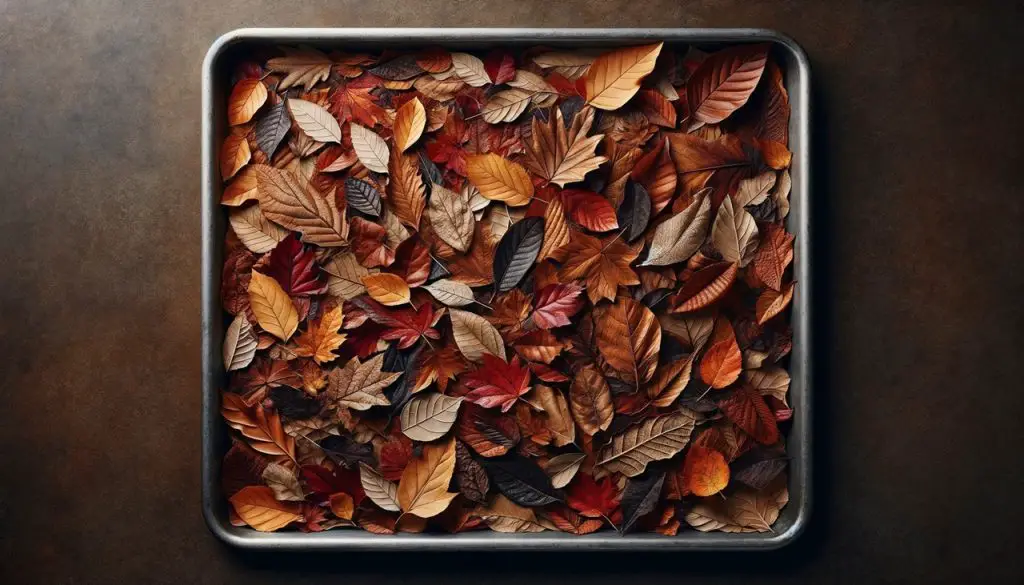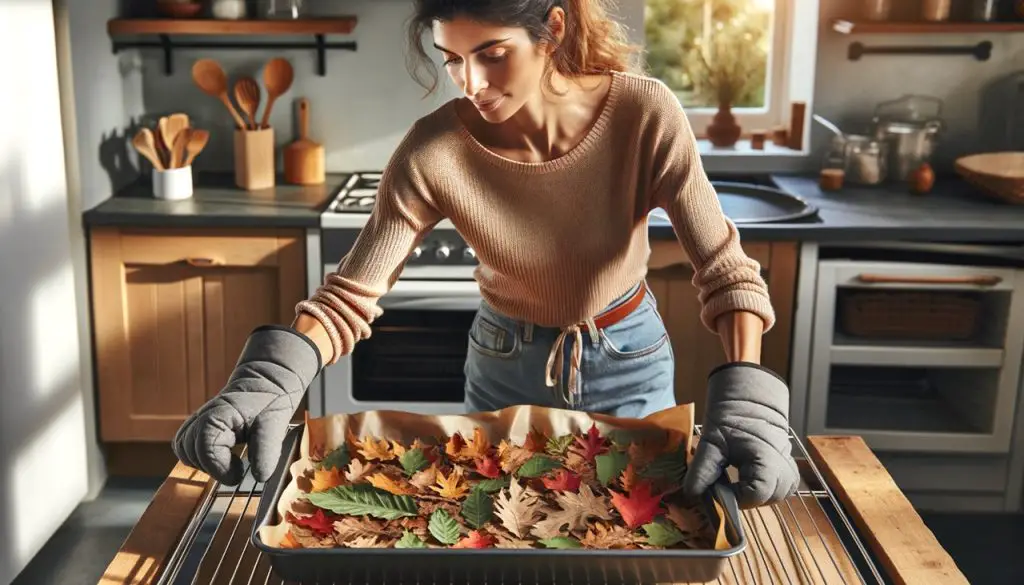You’ll learn how to oven dry leaves to preserve the beauty of nature in this article. Whether you’re into crafting, scrapbooking, or just looking for a fun project, this guide will take you through every step of the process. By the end of this article, you’ll be an expert at oven drying leaves, ready to create stunning pieces of natural art.

Table of Contents
Things You’ll Need: How to Oven Dry Leaves
- Fresh leaves of your choice
- A clean, dry towel
- Parchment paper
- Oven mitts
- A baking sheet
- Airtight storage containers
How to Oven Dry Leaves Step by Step
Follow the steps below to oven dry leaves…
Step 1: Preparing the Leaves
In this initial step, your goal is to choose the best leaves for drying and to prepare them properly. Start by picking fresh leaves. Look for leaves that are vibrant in color, without any signs of wilting, discoloration, or damage.
The ideal leaves should be sturdy, not too thin or fragile. If you’re picking leaves from outside, try to do so on a dry day, as wet leaves may be more challenging to work with.
Once you’ve gathered your leaves, it’s time to clean them. Place the leaves in a colander or on a clean surface. Rinse them gently under cold running water. This step is important for removing any dirt, dust, or small insects that may be on the leaves. Be gentle to avoid tearing or damaging the leaves.
After rinsing, lay out a clean, dry towel. Carefully spread the leaves on the towel in a single layer. Use another towel to pat the tops of the leaves gently. Make sure you absorb as much moisture as possible.
This drying process is crucial because any remaining moisture could lead to mold or uneven drying in the oven. Allow the leaves to air dry for a bit if necessary, ensuring they are completely dry before you move on to the next step.
Step 2: Preparing Your Baking Sheet
For this step, the focus is on preparing your baking sheet to ensure that the leaves dry evenly and can be removed easily after drying. Start by finding a flat baking sheet, preferably one that is large enough to accommodate the number of leaves you plan to dry without overcrowding them.
Next, take a sheet of parchment paper and cut it to fit the size of your baking sheet. Parchment paper is essential for a couple of reasons. Firstly, it provides a non-stick surface, ensuring that your leaves can be removed easily once they are dried.
Secondly, it helps protect the leaves from direct contact with the hot metal of the baking sheet, which can cause them to brown or burn. Lay the parchment paper smoothly on the baking sheet.
Try to avoid any significant creases or wrinkles in the paper, as this could lead to uneven drying. If your parchment paper tends to roll up, you can lightly grease the baking sheet with a thin layer of cooking spray before placing the parchment paper down. This step helps the paper adhere to the baking sheet and stay flat.
Step 3: Arranging the Leaves
In this step, your focus is on arranging the leaves on the baking sheet in a way that promotes even drying. Begin by taking your prepared leaves and placing them one by one onto the parchment paper-lined baking sheet.
It’s important to lay them out flat, ensuring they are not folded or crumpled, as this could cause uneven drying and possible discoloration or burning in creased areas.
Arrange the leaves in a single layer, giving each leaf its own space. Avoid any overlapping, as leaves that cover each other will not dry uniformly, which may result in some parts being overly dry while others remain moist.
The spacing also allows for proper air circulation around each leaf, which is crucial for effective drying. Think of it like baking cookies; you wouldn’t want them to stick together, and the same principle applies to drying leaves.
If you have more leaves than can fit on one baking sheet without overlapping, it’s better to use additional baking sheets rather than crowding them. Crowded leaves can steam instead of dry, leading to a less desirable outcome.
Read more on oven drying here – How to Oven Dry Stuff: Your Ultimate Guide to Drying Various Items in the Oven
Step 4: Preheating the Oven

Now it’s time to prepare your oven for drying the leaves. The goal here is to create a warm, consistent environment for the leaves to dry slowly and evenly. Start by setting your oven to its lowest possible temperature.
This is usually in the range of 170°F to 200°F (77°C to 93°C). If your oven doesn’t go this low, set it to the lowest temperature available, and keep a closer eye on the drying process to avoid any scorching.
The reason for using such a low temperature is that leaves are delicate and can easily burn or become too brittle at higher temperatures. By drying them slowly at a low heat, you’re allowing the moisture to evaporate gradually, preserving the color and shape of the leaves as much as possible.
This gentle drying process is what helps maintain the natural beauty of the leaves. After setting the temperature, let your oven preheat for a few minutes. This step ensures that the oven reaches a stable temperature before you put the leaves in.
An oven that’s not properly preheated can have hot spots or fluctuate in temperature, leading to uneven drying. Once the oven is preheated, it’s ready for the baking sheet with your arranged leaves.
Step 5: Drying the Leaves
This step is the heart of the process where the actual drying of the leaves takes place. Carefully place your baking sheet with the arranged leaves into the preheated oven.
The positioning of the baking sheet within the oven can affect the drying process. Ideally, place it in the middle rack to ensure even heat distribution. Now, patience plays a key role. The drying process generally takes about 2 to 4 hours, but this duration can vary.
Different types of leaves may have varying thicknesses and moisture content, affecting how long they take to dry. Thicker, more robust leaves, like those from a magnolia, might take longer than thinner leaves, like maple or birch.
It’s crucial to check on the leaves periodically throughout the drying process. This isn’t just to monitor their progress, but also to ensure that they are not drying too quickly or burning. If your oven has hot spots, you might need to rotate the baking sheet occasionally for even drying.
During this process, you might notice changes in the leaves’ color and texture. They’ll slowly lose their natural green hue and become more muted in tone. The texture will change from pliable and fresh to a more papery, crisp feel.
Step 6: Checking for Doneness
Determining when the leaves are perfectly dried is an art in itself. The end goal is to achieve leaves that are dry to the touch and slightly crispy. To check, carefully open the oven and use a pair of tongs or a spatula to gently lift a leaf.
Feel the texture. If the leaf still feels soft or pliable, it needs more time. If it’s crisp and feels dry, it’s likely done. Be mindful not to over-dry the leaves. Leaves that are left in the oven too long may become overly brittle.
This brittleness can make them prone to breaking or crumbling, which is especially important to avoid if you’re planning to use the leaves for crafts or decoration. Finding the right balance is key; you want them dry enough to be preserved, but not so dry that they lose their integrity.
Once you determine the leaves are adequately dried, it’s time to remove them from the oven. This step should be done with care, as the leaves are now delicate and can be easily damaged. Gently slide the parchment paper off the baking sheet onto a cool surface to allow the leaves to cool down.
Step 7: Cooling and Storing

After successfully drying your leaves in the oven, the final step involves cooling and storing them properly to maintain their preserved state. This phase is as crucial as the drying process because how you handle the leaves now will determine their longevity and usability.
Cooling the Leaves
Once you have determined that the leaves are adequately dried, remove the baking sheet from the oven. It’s important to do this carefully to avoid damaging the now delicate leaves. Use oven mitts or a kitchen towel to handle the hot baking sheet.
Place the baking sheet on a heat-resistant surface or a wire rack. This allows the leaves to cool down gradually. Cooling on a flat surface ensures that the leaves retain their shape and do not curl up or warp as they cool.
Let the leaves sit undisturbed for a while. This cooling period allows any residual heat to dissipate and brings the leaves to room temperature. Rushing this step or moving the leaves while they are still warm can lead to breakage or deformation, especially if they are still a bit flexible immediately after coming out of the oven.
Storing the Leaves
After the leaves have cooled completely, it’s time to store them. Choose a dry, airtight container for storage. This could be a plastic storage box, a glass jar, or any container that can be sealed well. The key here is to ensure that no moisture can enter the container, as this would rehydrate the leaves and potentially lead to mold or decay.
If you have different types or sizes of leaves, consider layering them between sheets of tissue paper within the container. This provides added protection and keeps the leaves from crushing or damaging each other.
Find a cool, dry place to store your container. This could be a cupboard, a shelf, or a storage area where the leaves are protected from humidity and direct sunlight. Direct sunlight can fade the colors of the leaves over time, while humidity can reintroduce moisture, negating the drying process.
Conclusion: How to Oven Dry Leaves
And that’s it! You now know how to oven dry leaves effectively. This method is ideal for preserving the beauty of fall or creating unique decorations and gifts. Happy drying!